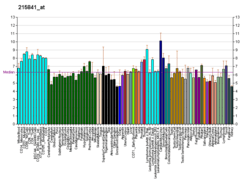GUCA1B
Guanylyl cyclase-activating protein 2 is an enzyme that in humans is encoded by the GUCA1B gene.[5][6] Alternative names:[7]
- Guanylate cyclase activator 1B
- Retinal guanylyl cyclase activator protein p24
References
- 1 2 3 GRCh38: Ensembl release 89: ENSG00000112599 - Ensembl, May 2017
- 1 2 3 GRCm38: Ensembl release 89: ENSMUSG00000023979 - Ensembl, May 2017
- ↑ "Human PubMed Reference:".
- ↑ "Mouse PubMed Reference:".
- ↑ Surguchov A, Bronson JD, Banerjee P, Knowles JA, Ruiz C, Subbaraya I, Palczewski K, Baehr W (Apr 1997). "The human GCAP1 and GCAP2 genes are arranged in a tail-to-tail array on the short arm of chromosome 6 (p21.1)". Genomics. 39 (3): 312–22. doi:10.1006/geno.1996.4513. PMID 9119368.
- ↑ "Entrez Gene: GUCA1B guanylate cyclase activator 1B (retina)".
- ↑ "GUCA1B - Guanylyl cyclase-activating protein 2 - Bos taurus (Bovine) - GUCA1B gene & protein". www.uniprot.org. Retrieved 2017-10-09.
Further reading
- Wiegand RC, Kato J, Huang MD, et al. (1992). "Human guanylin: cDNA isolation, structure, and activity". FEBS Lett. 311 (2): 150–4. doi:10.1016/0014-5793(92)81387-2. PMID 1327879.
- de Sauvage FJ, Keshav S, Kuang WJ, et al. (1992). "Precursor structure, expression, and tissue distribution of human guanylin". Proc. Natl. Acad. Sci. U.S.A. 89 (19): 9089–93. doi:10.1073/pnas.89.19.9089. PMC 50070. PMID 1409606.
- Otto-Bruc A, Fariss RN, Haeseleer F, et al. (1997). "Localization of guanylate cyclase-activating protein 2 in mammalian retinas". Proc. Natl. Acad. Sci. U.S.A. 94 (9): 4727–32. doi:10.1073/pnas.94.9.4727. PMC 20792. PMID 9114059.
- Laura RP, Hurley JB (1998). "The kinase homology domain of retinal guanylyl cyclases 1 and 2 specifies the affinity and cooperativity of interaction with guanylyl cyclase activating protein-2". Biochemistry. 37 (32): 11264–71. doi:10.1021/bi9809674. PMID 9698373.
- Sokal I, Haeseleer F, Arendt A, et al. (1999). "Identification of a guanylyl cyclase-activating protein-binding site within the catalytic domain of retinal guanylyl cyclase 1". Biochemistry. 38 (5): 1387–93. doi:10.1021/bi982512k. PMID 9931003.
- Payne AM, Downes SM, Bessant DA, et al. (1999). "Genetic analysis of the guanylate cyclase activator 1B (GUCA1B) gene in patients with autosomal dominant retinal dystrophies". J. Med. Genet. 36 (9): 691–3. doi:10.1136/jmg.36.9.691. PMC 1734430. PMID 10507726.
- Wistow G, Bernstein SL, Wyatt MK, et al. (2002). "Expressed sequence tag analysis of human retina for the NEIBank Project: retbindin, an abundant, novel retinal cDNA and alternative splicing of other retina-preferred gene transcripts". Mol. Vis. 8: 196–204. PMID 12107411.
- Strausberg RL, Feingold EA, Grouse LH, et al. (2003). "Generation and initial analysis of more than 15,000 full-length human and mouse cDNA sequences". Proc. Natl. Acad. Sci. U.S.A. 99 (26): 16899–903. doi:10.1073/pnas.242603899. PMC 139241. PMID 12477932.
- Mungall AJ, Palmer SA, Sims SK, et al. (2003). "The DNA sequence and analysis of human chromosome 6". Nature. 425 (6960): 805–11. doi:10.1038/nature02055. PMID 14574404.
- Sato M, Nakazawa M, Usui T, et al. (2005). "Mutations in the gene coding for guanylate cyclase-activating protein 2 (GUCA1B gene) in patients with autosomal dominant retinal dystrophies". Graefes Arch. Clin. Exp. Ophthalmol. 243 (3): 235–42. doi:10.1007/s00417-004-1015-7. PMID 15452722.
External links
This article is issued from
Wikipedia.
The text is licensed under Creative Commons - Attribution - Sharealike.
Additional terms may apply for the media files.




